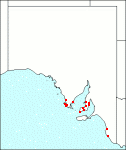Family: Euphorbiaceae
Adriana klotzschii
Citation:
Muell.-Arg. in A. DC., Prod. 15:893 (1866).
Synonymy: Trachycaryon klotzschii F. Muell., J. Trans. Vict. Inst. 1:15 (1854).
Common name: Coast bitterbush.
Description:
Spreading shrub, from under 1 to over 3 m high, stellate-tomentose or hoary-pubescent; leaves opposite, sessile or almost so, from ovate and 2.5 x 1.5 cm to lanceolate and 9 x 3 cm, obtusely serrate to distally crenate-toothed, rarely nearly entire, sometimes with slightly recurred margins, glabrous and glossy above, rarely with stellate hairs in crevices of the immersed veins, densely white-tomentose with matted stellate hairs beneath which the veins are distinct.
male spikes 5-17 cm long, peduncles reddish-brown, few- to 30-flowered, crowded distally; bracts reddish, ovate-acute, 5-11 mm long, glabrous or hoary all over or on the margins only; calyx of 4 or 5 ovate-lanceolate sepals 4-5 x 2-3 mm, mostly hoary; female spikes 1-3 cm long, 3-7-flowered; bract greenish, ovate, to 5 mm long, hoary- or stellate-pubescent; pedicel 1-2 mm long; calyx hoary- or stellate-pubescent, ovary and fruit stellate-tomentose; styles almost free, sometimes merely notched, 5-8 mm long, distinctly dark-red.
capsule subglobular to 3-lobed, 8-10 mm long and wide, greenish; seeds ovate, c. 4.5 x 3.5 mm, grey mottled brown to wholly brown, smooth, shiny.
|
Conservation status:
native
Flowering time: all year around but mostly in spring.
|

SA Distribution Map based
on current data relating to
specimens held in the
State Herbarium of South Australia
|
Biology:
Generally found in coastal sand dunes in colonies with both sexes present. Not known to be grazed.
Taxonomic notes:
The specimens from Koonamore and Plumbago Station (EA) show similarities with A. quadripartita from the Gawler Ranges in the size and shape of leaves and the red stems but they differ from them only in the stellate indumentum. The intergradation of these two species led J. Black (1948) Flora of South Australia, p. 514 and some other botanists to regard them as being conspecific, with the name A. quadripartita having priority.
Author:
Not yet available
|

